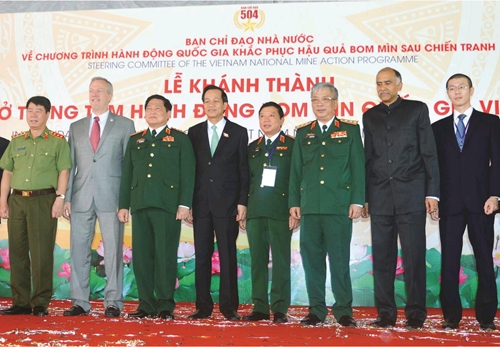The conferences are scheduled by the National Steering Committee on the Settlement of Post-war Unexploded Ordnance (UXO) and Toxic Chemical Consequences (Steering Committee 701) and a number of the UN and US agencies.
The People’s Army Newspaper would like to present a series of articles on the real situations and cooperation efforts of both sides in relieving war-left consequences.
War-left pains
The prolonged war has left terrible UXO and toxic chemical consequences in Vietnam, making it one of the countries heavily-affected by war consequences in the world.
According to Steering Committee 701, from 1964 to 1975, more than 16 million tons of bombs and ammunition of all kinds were used in Vietnam, more than four times of the total bomb and ammunitions used in the First World War.
The figures from the Vietnam National Mine Action Center (VNMAC) published on April 3, 2018, show that the ammunition left-over after the war in Vietnam amounts to hundreds of thousand tons.
The remnants of unexploded ordnance scatter in almost all provinces and cities nationwide. There are at present 9,116 communes in the 63 provinces of Vietnam, accounting for 81.87% of all the communes of the countries, are contaminated with UXO at different levels. The total UXO-contaminated land area as of December 2017 stood at more than 6.1 million hectares, accounting for 18.71% of the whole area of Vietnam.
Among localities heavily-contaminated with UXO, mostly in the Central region (including the Central Highlands), Quang Tri is the province with the largest area of UXO-contamination.
In terms of UXO victims, according to the statistics of the Vietnam Association for Supporting UXO/Mine Action Efforts (VNASMA), from 1975 to 2002, war-left UXO affected 105,298 people, including 42,135 dead, 30% of whom are children. Forty-nine out of 63 provinces and cities experienced UXO accidents. In the recent five years, the number of people dead and injured by UXO reached 1,800.
The war ended decades now; however, its consequences left to the socio-economic life and people of Vietnam, just in terms of UXO count, remain severe.
    |
 |
|
Delegates at the inauguration ceremony for the Vietnam National Mine Action Center |
All resources mobilized to ease UXO consequences
In April 2010, the Government of Vietnam kick-started the National action program on the settlement of UXO consequences for the period of 2010-2025. The program aims to mobilize resources of the country and from the international community to mitigate and head for the total clearance of UXO consequences, facilitating socio-economic development and defense-security maintenance for the people while helping UXO victims integrate in the community.
From 2016 to 2018, nearly 3,000 UXO clearance projects were implemented on the total area of more than 90,000 hectares, costing roughly VND 2,840 billion (nearly USD 122.5 million). In April 2018, the VNMAC published the “Report on the real situation of UXO in Vietnam – Phase 1,” picturing the situation of the UXO-contamination in the whole country, helping zone off areas requiring more priorities, efforts and resources. The Government of Vietnam has directed the establishment of the national UXO database center tasked with collecting information and data about UXO consequence settlement activities nationwide, implementing dissemination activities to raise awareness of UXO for people living in UXO-contaminated areas, and hosting UXO research projects.
The people and Government of Vietnam attach special importance to UXO victims via activities implemented by ministries, sectors and organizations like the VNASMA. The victims and their families receive support in the forms of livelihood support, husbandry guidance, and machinery operation instruction, etc. During the 2014-2018 period, about 5,000 people were supported by the VNASMA with the resources donated by politico-social organizations, individuals, businesses. The Government of Vietnam also implemented various preferential policies for UXO victims.
Helping hands
Governments of other countries and international organizations have also joined hands to speed up efforts of UXO consequence relief. Major partners of Vietnam in the field include Japan, the US, the Republic of Korea, the UK and a number of organizations like the MAG, the NAP and the GICHD.
Since 2009, Japan has supported Vietnam with USD 5.5 million to implement two UXO clearance projects. The US Government has supported Vietnam in the 2003-2013 and the 2016-present periods. In the first period, the US provided Vietnam with UXO detection and clearance equipment and support in surveying and mapping UXO-contaminated areas in six provinces in the Central region at the total cost of USD 14.5 million. Since 2016, the country has supported Vietnam to carry out seven agreed contents related to technical assistance, training and surveying.
The Korea Organization of International Cooperation Agency (KOICA) of the Republic of Korea (RoK) has aided Vietnam with USD 20 million to implement the project “Vietnam – RoK cooperation in UXO consequence relief in Quang Tri and Binh Dinh provinces.”
Other organizations like UNICEF, Peace Trees Vietnam, SODI of Germany, CRS, RENEW, etc. have also lent helping hands in disseminating the information about how to avoid UXO accidents in localities.
Meanwhile, the governments of the UK, Belgium, India have admitted Vietnamese officials to training courses on the management and organization of UXO consequence relief activities. The governments of Hungary, Italy, Poland, Australia, Sri Lanka, Czech Republic are considering support for Vietnam in this field.
Together with Vietnam’s efforts, support from other countries and international organizations have added to the mitigation of UXO consequences, helping bring life to dead lands and ease the UXO pains in Vietnam.
(to be cont.)
Translated by Huu Duong